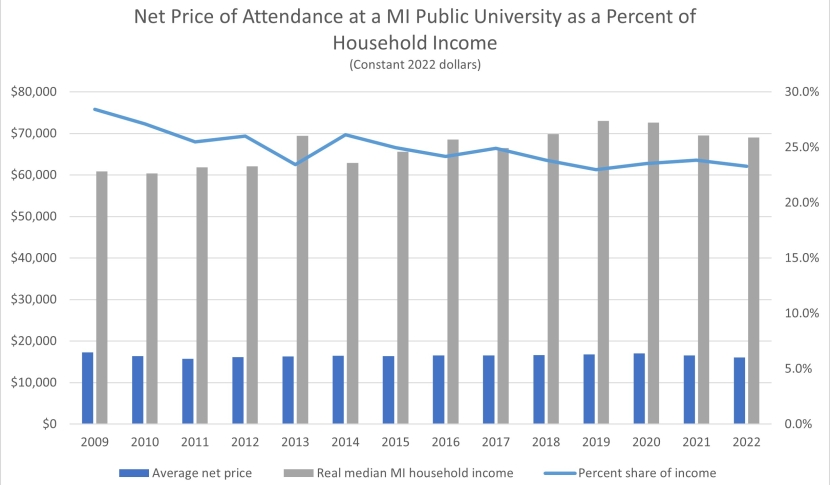Michigan public universities are more affordable than they were at the start of the Obama Administration

Michigan public universities are more affordable than they were at the start of the Obama Administration
Michigan’s public universities have learned to do more with less for many years now. While recent state budgets have been a well appreciated re-investment, institutions responded to years of cuts or stagnation by holding the line on affordability for students and families. This chart above shows exactly how dedicated the state universities have been to keeping the net price of attendance low for students since the state sharply reduced its financial aid programs starting in 2009.
This chart represents three things: the average net price of attendance after all financial aid is factored in (including federal, state, and institutional grants, not including any loans); real median household income here in Michigan; and what that net price of a university education is as a percentage of that household income. In other words, we can use this chart to place a family’s investment in a college education into the context of their assets.
Two things are striking. First, the average net price has not only held the line, it’s actually decreased! Net price of attendance was 7% less in 2022 than in 2009, declining from $17,299 to $16,054. This chart is inflation adjusted, but only by traditional CPI-U figures, and not any special higher education inflator. The public universities in this state intentionally and successfully held the price of attendance roughly flat for students receiving financial aid in the years since the state’s major budget cuts in 2009. They did that in part by intentionally investing in institutional financial aid to students, which is now over $1.1 billion annually.
Second, the percentage of the net price of college as a share of household income has dropped, too. At its peak in 2009, paying for a year of college education was 28.4% of a household’s annual income. That’s now declined to 23.3% as of 2022 – an 18% drop! I attribute this to several causes including universities holding tuition increases to a minimum, making difficult but strategic spending reductions, providing much more institutional financial aid to students with need, and a growing Michigan economy.
What I find particularly optimistic is that these data precede the large investments in state appropriations or state financial aid in the last two budget cycles. I am confident that future data will show net price as a percentage of state income has continued to drop, only becoming more affordable to Michigan families as a result of the state funding university operations and the Michigan Achievement Scholarship. When all forms of financial aid are factored in, the average net price of attending a Michigan public university is reduced by 40%—and that’s without including the new Michigan Achievement Scholarship. That scholarship—expected to impact nearly two-thirds of students enrolled at our public universities—represents between 30% and 45% of the cost of tuition at these institutions, reducing the net price of attendance even further.
The bottom line: Michigan’s public universities are cutting costs, investing savings into student financial aid, and reducing the net price of attending these institutions. Let’s keep the momentum rolling.
Mia Murphy is the Chief Policy Officer at the Michigan Association of State Universities.